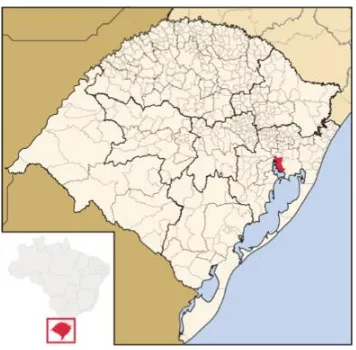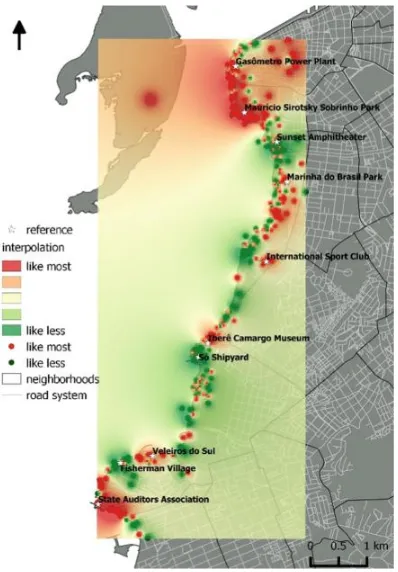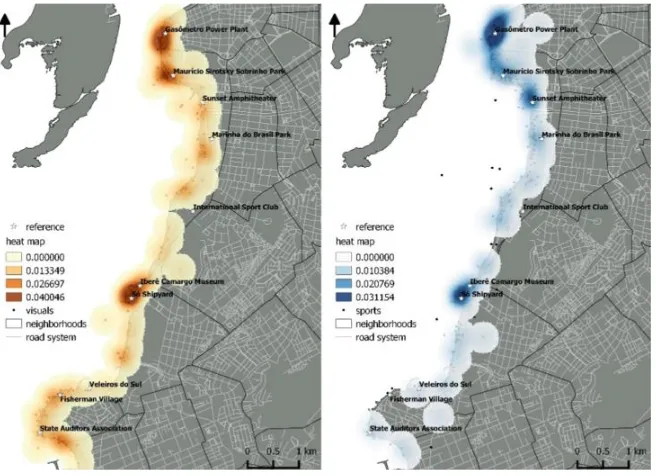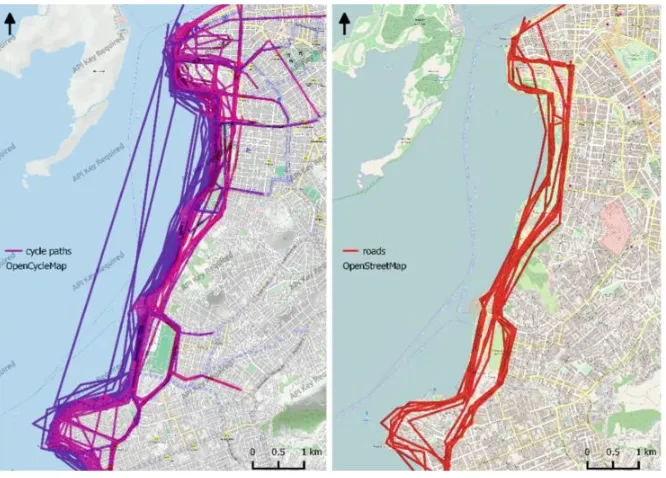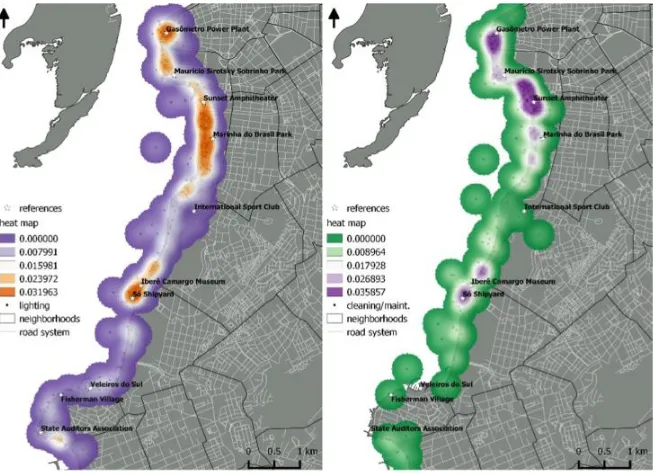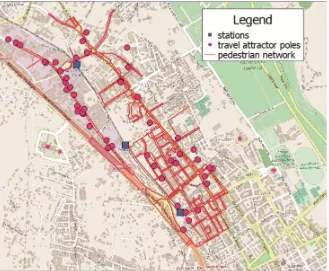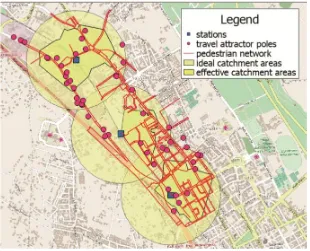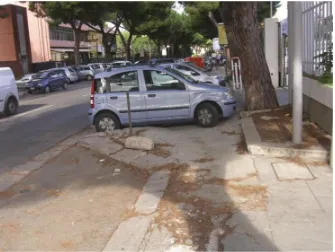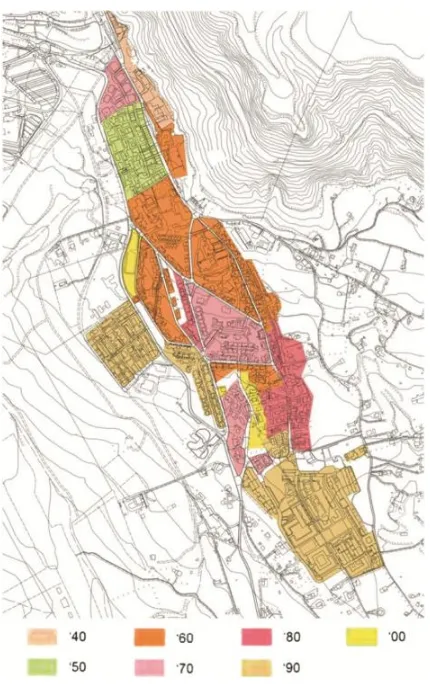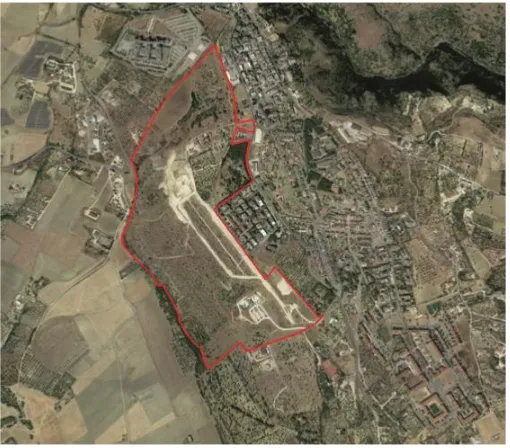Osvaldo Gervasi · Beniamino Murgante
Sanjay Misra · Elena Stankova
Carmelo M. Torre · Ana Maria A. C. Rocha
David Taniar · Bernady O. Apduhan
Eufemia Tarantino · Yeonseung Ryu
(Eds.)
123
LNCS 10964
18th International Conference
Melbourne, VIC, Australia, July 2–5, 2018
Proceedings, Part V
Lecture Notes in Computer Science
10964
Commenced Publication in 1973 Founding and Former Series Editors:
Gerhard Goos, Juris Hartmanis, and Jan van Leeuwen
Editorial Board
David Hutchison
Lancaster University, Lancaster, UK Takeo Kanade
Carnegie Mellon University, Pittsburgh, PA, USA Josef Kittler
University of Surrey, Guildford, UK Jon M. Kleinberg
Cornell University, Ithaca, NY, USA Friedemann Mattern
ETH Zurich, Zurich, Switzerland John C. Mitchell
Stanford University, Stanford, CA, USA Moni Naor
Weizmann Institute of Science, Rehovot, Israel C. Pandu Rangan
Indian Institute of Technology Madras, Chennai, India Bernhard Steffen
TU Dortmund University, Dortmund, Germany Demetri Terzopoulos
University of California, Los Angeles, CA, USA Doug Tygar
University of California, Berkeley, CA, USA Gerhard Weikum
Osvaldo Gervasi
•Beniamino Murgante
Sanjay Misra
•Elena Stankova
Carmelo M. Torre
•Ana Maria A. C. Rocha
David Taniar
•Bernady O. Apduhan
Eufemia Tarantino
•Yeonseung Ryu (Eds.)
Computational Science
and Its Applications
–
ICCSA 2018
18th International Conference
Melbourne, VIC, Australia, July 2
–
5, 2018
Proceedings, Part V
Editors
Library of Congress Control Number: 2018947453
LNCS Sublibrary: SL1–Theoretical Computer Science and General Issues ©Springer International Publishing AG, part of Springer Nature 2018
Chapter“Nitrogen Gas on Graphene: Pairwise Interaction Potentials” is licensed under the terms of the Creative Commons Attribution 4.0 International License (http://creativecommons.org/licenses/by/4.0/). For further details see license information in the chapter.
This work is subject to copyright. All rights are reserved by the Publisher, whether the whole or part of the material is concerned, specifically the rights of translation, reprinting, reuse of illustrations, recitation, broadcasting, reproduction on microfilms or in any other physical way, and transmission or information storage and retrieval, electronic adaptation, computer software, or by similar or dissimilar methodology now known or hereafter developed.
The use of general descriptive names, registered names, trademarks, service marks, etc. in this publication does not imply, even in the absence of a specific statement, that such names are exempt from the relevant protective laws and regulations and therefore free for general use.
The publisher, the authors and the editors are safe to assume that the advice and information in this book are believed to be true and accurate at the date of publication. Neither the publisher nor the authors or the editors give a warranty, express or implied, with respect to the material contained herein or for any errors or omissions that may have been made. The publisher remains neutral with regard to jurisdictional claims in published maps and institutional affiliations.
Printed on acid-free paper
This Springer imprint is published by the registered company Springer International Publishing AG part of Springer Nature
Preface
These multiple volumes (LNCS volumes 10960–10964) consist of the peer-reviewed papers presented at the 2018 International Conference on Computational Science and Its Applications (ICCSA 2018) held in Melbourne, Australia, during July 2–5, 2018.
ICCSA 2018 was a successful event in the International Conferences on Compu-tational Science and Its Applications (ICCSA) conference series, previously held in Trieste, Italy (2017), Beijing, China (2016), Banff, Canada (2015), Guimaraes, Portugal (2014), Ho Chi Minh City, Vietnam (2013), Salvador, Brazil (2012), Santander, Spain (2011), Fukuoka, Japan (2010), Suwon, South Korea (2009), Perugia, Italy (2008), Kuala Lumpur, Malaysia (2007), Glasgow, UK (2006), Singapore (2005), Assisi, Italy (2004), Montreal, Canada (2003), and (as ICCS) Amsterdam, The Netherlands (2002) and San Francisco, USA (2001).
Computational science is a main pillar of most current research and industrial and commercial activities and it plays a unique role in exploiting ICT innovative tech-nologies. The ICCSA conference series has been providing a venue to researchers and industry practitioners to discuss new ideas, to share complex problems and their solutions, and to shape new trends in computational science.
Apart from the general tracks, ICCSA 2018 also included 33 international work-shops, in various areas of computational sciences, ranging from computational science technologies, to specific areas of computational sciences, such as computer graphics and virtual reality. The program also featured three keynote speeches.
The success of the ICCSA conference series, in general, and ICCSA 2018, in particular, is due to the support of many people: authors, presenters, participants, keynote speakers, session chairs, Organizing Committee members, student volunteers, Program Committee members, International Advisory Committee members, Interna-tional Liaison chairs, and people in other various roles. We would like to thank them all.
We would also like to thank Springer for their continuous support in publishing the ICCSA conference proceedings and for sponsoring some of the paper awards.
July 2018 David Taniar
Welcome to Melbourne
Welcome to“The Most Liveable City”1, Melbourne, Australia. ICCSA 2018 was held at Monash University, Caulfield Campus, during July 2–5, 2018.
Melbourne is the state capital of Victoria, and is currently the second most populous city in Australia, behind Sydney. There are lots of things to do and experience while in Melbourne. Here is an incomplete list:
– Visit and experience Melbourne’s best coffee shops – Discover Melbourne’s hidden laneways and rooftops – Walk along the Yarra River
– Eat your favourite food (Chinese, Vietnamese, Malaysian, Italian, Greek, anything, …you name it)
– Buy souvenirs at the Queen Victoria Market
– Go up to the Eureka, the tallest building in Melbourne – Visit Melbourne’s museums
– Walk and enjoy Melbourne’s gardens and parks
– Visit the heart-shape lake, Albert Park Lake, the home of the F1 Grand Prix – Simply walk in the city to enjoy Melbourne experience
– Try Melbourne’s gelato ice cream
Basically, it is easy to live in and to explore Melbourne, and I do hope that you will have time to explore the city of Melbourne.
The venue of ICCSA 2018 was in Monash University. Monash University is a member of Go8, which is considered the top eight universities in Australia. Monash University has a number of campuses and centers. The two main campuses in Mel-bourne are Clayton and Caulfield. ICCSA 2018 was held on Caulfield Campus, which is only 12 minutes away from Melbourne CBD by train.
The Faculty of Information Technology is one of the ten faculties at Monash University. The faculty has more than 100 full-time academic staff (equivalent to the rank of Assistant Professor, Associate Professor, and Professor).
I do hope that you will enjoy not only the conference, but also Melbourne.
David Taniar
Organization
ICCSA 2018 was organized by Monash University (Australia), University of Perugia (Italy), Kyushu Sangyo University (Japan), University of Basilicata (Italy), and University of Minho, (Portugal).
Honorary General Chairs
Antonio Laganà University of Perugia, Italy Norio Shiratori Tohoku University, Japan Kenneth C. J. Tan Sardina Systems, Estonia
General Chairs
David Taniar Monash University, Australia Bernady O. Apduhan Kyushu Sangyo University, Japan
Program Committee Chairs
Osvaldo Gervasi University of Perugia, Italy Beniamino Murgante University of Basilicata, Italy Ana Maria A. C. Rocha University of Minho, Portugal
International Advisory Committee
Jemal Abawajy Deakin University, Australia Dharma P. Agrawal University of Cincinnati, USA Marina L. Gavrilova University of Calgary, Canada Claudia Bauzer Medeiros University of Campinas, Brazil
Manfred M. Fisher Vienna University of Economics and Business, Austria Yee Leung Chinese University of Hong Kong, SAR China
International Liaison Chairs
Ana Carla P. Bitencourt Universidade Federal do Reconcavo da Bahia, Brazil Giuseppe Borruso University of Trieste, Italy
Rafael D. C. Santos National Institute for Space Research, Brazil Maribel Yasmina Santos University of Minho, Portugal
Workshop and Session Organizing Chairs
Beniamino Murgante University of Basilicata, Italy Sanjay Misra Covenant University, Nigeria Jorge Gustavo Rocha University of Minho, Portugal
Award Chair
Wenny Rahayu La Trobe University, Australia
Web Chair
A. S. M. Kayes La Trobe University, Australia
Publicity Committee Chairs
Elmer Dadios De La Salle University, Philippines
Hong Quang Nguyen International University (VNU-HCM), Vietnam Daisuke Takahashi Tsukuba University, Japan
Shangwang Wang Beijing University of Posts and Telecommunications, China
Workshop Organizers
Advanced Methods in Fractals and Data Mining for Applications (AMFDMA 2018)
Yeliz Karaca IEEE
Carlo Cattani Tuscia University, Italy
Majaz Moonis University of Massachusettes Medical School, USA
Advances in Information Systems and Technologies for Emergency Management, Risk Assessment and Mitigation Based on Resilience Concepts (ASTER 2018)
Maurizio Pollino ENEA, Italy
Marco Vona University of Basilicata, Italy Beniamino Murgante University of Basilicata, Italy Grazia Fattoruso ENEA, Italy
Advances in Web-Based Learning (AWBL 2018)
Bio- and Neuro-inspired Computing and Applications (BIONCA 2018)
Nadia Nedjah State University of Rio de Janeiro, Brazil Luiza de Macedo Mourell State University of Rio de Janeiro, Brazil
Computer-Aided Modeling, Simulation, and Analysis (CAMSA 2018)
Jie Shen University of Michigan, USA
Hao Chen Shanghai University of Engineering Science, China
Youguo He Jiangsu University, China
Computational and Applied Statistics (CAS 2018)
Ana Cristina Braga University of Minho, Portugal
Computational Geometry and Security Applications (CGSA 2018)
Marina L. Gavrilova University of Calgary, Canada
Computational Movement Analysis (CMA 2018)
Farid Karimipour University of Tehran, Iran
Computational Mathematics, Statistics and Information Management (CMSIM 2018)
M. Filomena Teodoro Lisbon University and Portuguese Naval Academy, Portugal
Computational Optimization and Applications (COA 2018)
Ana Maria Rocha University of Minho, Portugal Humberto Rocha University of Coimbra, Portugal
Computational Astrochemistry (CompAstro 2018)
Marzio Rosi University of Perugia, Italy
Dimitrios Skouteris Scuola Normale Superiore di Pisa, Italy Albert Rimola Universitat Autònoma de Barcelona, Spain
Cities, Technologies, and Planning (CTP 2018)
Giuseppe Borruso University of Trieste, Italy Beniamino Murgante University of Basilicata, Italy
Defense Technology and Security (DTS 2018)
Yeonseung Ryu Myongji University, South Korea
Econometrics and Multidimensional Evaluation in the Urban Environment (EMEUE 2018)
Carmelo M. Torre Polytechnic of Bari, Italy
Maria Cerreta University of Naples Federico II, Italy Pierluigi Morano Polytechnic of Bari, Italy
Paola Perchinunno University of Bari, Italy
Future Computing Systems, Technologies, and Applications (FISTA 2018)
Bernady O. Apduhan Kyushu Sangyo University, Japan
Rafael Santos National Institute for Space Research, Brazil
Shangguang Wang Beijing University of Posts and Telecommunications, China
Kazuaki Tanaka Kyushu Institute of Technology, Japan
Geographical Analysis, Urban Modeling, Spatial Statistics (GEO-AND-MOD 2018)
Giuseppe Borruso University of Trieste, Italy Beniamino Murgante University of Basilicata, Italy Hartmut Asche University of Potsdam, Germany
Geomatics for Resource Monitoring and Control (GRMC 2018)
Eufemia Tarantino Polytechnic of Bari, Italy Umberto Fratino Polytechnic of Bari, Italy Benedetto Figorito ARPA Puglia, Italy Antonio Novelli Polytechnic of Bari, Italy
Rosa Lasaponara Italian Research Council, IMAA-CNR, Italy
International Symposium on Software Quality (ISSQ 2018)
Sanjay Misra Covenant University, Nigeria
Web-Based Collective Evolutionary Systems: Models, Measures, Applications (IWCES 2018)
Alfredo Milani University of Perugia, Italy
Clement Leung United International College, Zhouhai, China Valentina Franzoni University of Rome La Sapienza, Italy Valentina Poggioni University of Perugia, Italy
Large-Scale Computational Physics (LSCP 2018)
Elise de Doncker Western Michigan University, USA
Fukuko Yuasa High Energy Accelerator Research Organization, KEK, Japan
Hideo Matsufuru High Energy Accelerator Research Organization, KEK, Japan
Land Use Monitoring for Soil Consumption Reduction (LUMS 2018)
Carmelo M. Torre Polytechnic of Bari, Italy Alessandro Bonifazi Polytechnic of Bari, Italy Pasquale Balena Polytechnic of Bari, Italy Beniamino Murgante University of Basilicata , Italy Eufemia Tarantino Polytechnic of Bari, Italy
Mobile Communications (MC 2018)
Hyunseung Choo Sungkyunkwan University, South Korea
Scientific Computing Infrastructure (SCI 2018)
Elena Stankova Saint-Petersburg State University, Russia Vladimir Korkhov Saint-Petersburg State University, Russia
International Symposium on Software Engineering Processes and Applications (SEPA 2018)
Sanjay Misra Covenant University, Nigeria
Smart Factory Convergence (SFC 2018)
Jongpil Jeong Sungkyunkwan University, South Korea
Is a Smart City Really Smart? Models, Solutions, Proposals for an Effective Urban and Social Development (Smart_Cities 2018)
Giuseppe Borruso University of Trieste, Italy Chiara Garau University of Cagliari, Italy Ginevra Balletto University of Cagliari, Italy Beniamino Murgante University of Basilicata, Italy Paola Zamberlin University of Florence, Italy
Sustainability Performance Assessment: Models, Approaches and Applications Toward Interdisciplinary and Integrated Solutions (SPA 2018)
Francesco Scorza University of Basilicata, Italy
Valentin Grecu Lucia Blaga University on Sibiu, Romania Jolanta Dvarioniene Kaunas University, Lithuania
Sabrina Lai Cagliari University, Italy
Advances in Spatio-Temporal Analytics (ST-Analytics 2018)
Rafael Santos Brazilian Space Research Agency, Brazil Karine Reis Ferreira Brazilian Space Research Agency, Brazil Joao Moura Pires New University of Lisbon, Portugal Maribel Yasmina Santos University of Minho, Portugal
Theoretical and Computational Chemistry and Its Applications (TCCA 2018)
M. Noelia Faginas Lago University of Perugia, Italy Andrea Lombardi University of Perugia, Italy
Tools and Techniques in Software Development Processes (TTSDP 2018)
Sanjay Misra Covenant University, Nigeria
Challenges, Trends and Innovations in VGI (VGI 2018)
Beniamino Murgante University of Basilicata, Italy
Rodrigo Tapia-McClung Centro de Investigación en Geografia y Geomática Ing Jorge L. Tamay, Mexico
Claudia Ceppi Polytechnic of Bari, Italy Jorge Gustavo Rocha University of Minho, Portugal
Virtual Reality and Applications (VRA 2018)
Osvaldo Gervasi University of Perugia, Italy Sergio Tasso University of Perugia, Italy
International Workshop on Parallel and Distributed Data Mining (WPDM 2018)
Massimo Cafaro University of Salento, Italy Italo Epicoco University of Salento, Italy Marco Pulimeno University of Salento, Italy Giovanni Aloisio University of Salento, Italy
Program Committee
Kenny Adamson University of Ulster, UK Vera Afreixo University of Aveiro, Portugal Filipe Alvelos University of Minho, Portugal Hartmut Asche University of Potsdam, Germany Michela Bertolotto University College Dublin, Ireland
Sandro Bimonte CEMAGREF, TSCF, France
Rod Blais University of Calgary, Canada
Ivan Blec̆ić University of Sassari, Italy Giuseppe Borruso University of Trieste, Italy Ana Cristina Braga University of Minho, Portugal
Yves Caniou Lyon University, France
JoséA. Cardoso e Cunha Universidade Nova de Lisboa, Portugal Rui Cardoso University of Beira Interior, Portugal Leocadio G. Casado University of Almeria, Spain Carlo Cattani University of Salerno, Italy
Mete Celik Erciyes University, Turkey
Alexander Chemeris National Technical University of Ukraine KPI, Ukraine Min Young Chung Sungkyunkwan University, South Korea
Florbela Maria da Cruz Domingues Correia
Polytechnic Institute of Viana do Castelo, Portugal
Gilberto Corso Pereira Federal University of Bahia, Brazil
Carla Dal Sasso Freitas Universidade Federal do Rio Grande do Sul, Brazil Pradesh Debba The Council for Scientific and Industrial Research
(CSIR), South Africa
Hendrik Decker Instituto Tecnológico de Informática, Spain Frank Devai London South Bank University, UK
Rodolphe Devillers Memorial University of Newfoundland, Canada Joana Matos Dias University of Coimbra, Portugal
Paolino Di Felice University of L’Aquila, Italy
Prabu Dorairaj NetApp, India/USA
M. Irene Falcao University of Minho, Portugal Cherry Liu Fang U.S. DOE Ames Laboratory, USA Florbela P. Fernandes Polytechnic Institute of Bragança, Portugal Jose-Jesus Fernandez National Centre for Biotechnology, CSIS, Spain Paula Odete Fernandes Polytechnic Institute of Bragança, Portugal Adelaide de Fátima Baptista
Valente Freitas
University of Aveiro, Portugal
Manuel Carlos Figueiredo University of Minho, Portugal Maria Antonia Forjaz University of Minho, Portugal Maria Celia Furtado Rocha PRODEB–PósCultura/UFBA, Brazil Paulino Jose Garcia Nieto University of Oviedo, Spain
Jerome Gensel LSR-IMAG, France
Maria Giaoutzi National Technical University, Athens, Greece Arminda Manuela Andrade
Pereira Gonçalves
University of Minho, Portugal
Andrzej M. Goscinski Deakin University, Australia
Sevin Gm̈gm̈ Izmir University of Economics, Turkey Alex Hagen-Zanker University of Cambridge, UK
Malgorzata Hanzl Technical University of Lodz, Poland Shanmugasundaram
Hariharan
B.S. Abdur Rahman University, India
Eligius M. T. Hendrix University of Malaga/Wageningen University, Spain/The Netherlands
Tutut Herawan Universitas Teknologi Yogyakarta, Indonesia Hisamoto Hiyoshi Gunma University, Japan
Fermin Huarte University of Barcelona, Spain Mustafa Inceoglu EGE University, Turkey Peter Jimack University of Leeds, UK
Qun Jin Waseda University, Japan
A. S. M. Kayes La Trobe University, Australia
Farid Karimipour Vienna University of Technology, Austria
Baris Kazar Oracle Corp., USA
Maulana Adhinugraha Kiki Telkom University, Indonesia
DongSeong Kim University of Canterbury, New Zealand
Taihoon Kim Hannam University, South Korea
Ivana Kolingerova University of West Bohemia, Czech Republic Rosa Lasaponara National Research Council, Italy
Maurizio Lazzari National Research Council, Italy Cheng Siong Lee Monash University, Australia Sangyoun Lee Yonsei University, South Korea
Jongchan Lee Kunsan National University, South Korea Clement Leung Hong Kong Baptist University, Hong Kong, SAR
China
Chendong Li University of Connecticut, USA
Gang Li Deakin University, Australia
Ming Li East China Normal University, China
Fang Liu AMES Laboratories, USA
Xin Liu University of Calgary, Canada
Savino Longo University of Bari, Italy
Tinghuai Ma NanJing University of Information Science and Technology, China
Luca Mancinelli Trinity College Dublin, Ireland
Ernesto Marcheggiani Katholieke Universiteit Leuven, Belgium Antonino Marvuglia Research Centre Henri Tudor, Luxembourg Nicola Masini National Research Council, Italy
Eric Medvet University of Trieste, Italy
Nirvana Meratnia University of Twente, The Netherlands Alfredo Milani University of Perugia, Italy
Giuseppe Modica University of Reggio Calabria, Italy JosèLuis Montaña University of Cantabria, Spain Maria Filipa Mourão IP from Viana do Castelo, Portugal Laszlo Neumann University of Girona, Spain Kok-Leong Ong Deakin University, Australia Belen Palop Universidad de Valladolid, Spain Marcin Paprzycki Polish Academy of Sciences, Poland Eric Pardede La Trobe University, Australia Kwangjin Park Wonkwang University, South Korea Ana Isabel Pereira Polytechnic Institute of Bragança, Portugal
Maurizio Pollino Italian National Agency for New Technologies, Energy and Sustainable Economic Development, Italy Alenka Poplin University of Hamburg, Germany
Vidyasagar Potdar Curtin University of Technology, Australia David C. Prosperi Florida Atlantic University, USA
Wenny Rahayu La Trobe University, Australia
Jerzy Respondek Silesian University of Technology, Poland Humberto Rocha INESC-Coimbra, Portugal
Jon Rokne University of Calgary, Canada
Octavio Roncero CSIC, Spain
Maytham Safar Kuwait University, Kuwait
Chiara Saracino A.O. Ospedale Niguarda Ca’Granda - Milano, Italy Haiduke Sarafian The Pennsylvania State University, USA
Marco Paulo Seabra dos Reis
University of Coimbra, Portugal
Jie Shen University of Michigan, USA
Qi Shi Liverpool John Moores University, UK
Dale Shires U.S. Army Research Laboratory, USA Inês Soares University of Coimbra, Portugal Takuo Suganuma Tohoku University, Japan Sergio Tasso University of Perugia, Italy
Ana Paula Teixeira University of Trás-os-Montes and Alto Douro, Portugal Senhorinha Teixeira University of Minho, Portugal
Parimala Thulasiraman University of Manitoba, Canada Carmelo Torre Polytechnic of Bari, Italy
Javier Martinez Torres Centro Universitario de la Defensa Zaragoza, Spain Giuseppe A. Trunfio University of Sassari, Italy
Toshihiro Uchibayashi Kyushu Sangyo University, Japan Pablo Vanegas University of Cuenca, Ecuador Marco Vizzari University of Perugia, Italy
Varun Vohra Merck Inc., USA
Koichi Wada University of Tsukuba, Japan
Krzysztof Walkowiak Wroclaw University of Technology, Poland Zequn Wang Intelligent Automation Inc., USA
Robert Weibel University of Zurich, Switzerland
Frank Westad Norwegian University of Science and Technology, Norway
Roland Wismüller Universität Siegen, Germany Mudasser Wyne SOET National University, USA
Chung-Huang Yang National Kaohsiung Normal University, Taiwan Xin-She Yang National Physical Laboratory, UK
Salim Zabir France Telecom Japan Co., Japan Haifeng Zhao University of California, Davis, USA Kewen Zhao University of Qiongzhou, China Fabiana Zollo University of Venice CàFoscari, Italy Albert Y. Zomaya University of Sydney, Australia
Reviewers
Afreixo Vera University of Aveiro, Portugal
Ahmad Rashid Microwave and Antenna Lab, School of Engineering, Korea
Aguilar JoséAlfonso Universidad Autónoma de Sinaloa, Mexico Albanese Valentina Universitàdi Bologna, Italy
Alvelos Filipe University of Minho, Portugal Amato Federico University of Basilicata, Italy
Andrianov Serge Institute for Informatics of Tatarstan Academy of Sciences, Russia
Antunes Marília University Nova de Lisboa, Portugal Apduhan Bernady Kyushu Sangyo University, Japan Aquilanti Vincenzo University of Perugia, Italy Asche Hartmut Potsdam University, Germany Aslan Zafer Istanbul Aydin University, Turkey
AytaçVecdi Ege University, Turkey
Azevedo Ana Instituto Superior de Engenharia do Porto, Portugal Azzari Margherita Universitádegli Studi di Firenze, Italy
Bae Ihn-Han Catholic University of Daegu, South Korea Balci Birim Celal BayarÜniversitesi, Turkey
Balena Pasquale Politecnico di Bari, Italy Balucani Nadia University of Perugia, Italy
Barroca Filho Itamir Instituto Metrópole Digital da UFRN (IMD-UFRN), Brazil
Bayrak§sengül HaliçUniversity, Turkey
Behera Ranjan Kumar Indian Institute of Technology Patna, India
Bimonte Sandro IRSTEA, France
Bogdanov Alexander Saint-Petersburg State University, Russia Bonifazi Alessandro Polytechnic of Bari, Italy
Borruso Giuseppe University of Trieste, Italy Braga Ana Cristina University of Minho, Portugal Cafaro Massimo University of Salento, Italy Canora Filomena University of Basilicata, Italy Cao Yuanlong University of Saskatchewan, Canada Caradonna Grazia Polytechnic of Bari, Italy
Cardoso Rui Institute of Telecommunications, Portugal Carolina Tripp Barba Universidad Autónoma de Sinaloa, Mexico Caroti Gabriella University of Pisa, Italy
Ceccarello Matteo University of Padova, Italy Cefalo Raffaela University of Trieste, Italy
Cerreta Maria University Federico II of Naples, Italy Challa Rajesh Sungkyunkwan University, Korea Chamundeswari Arumugam SSN College of Engineering, India Chaturvedi Krishna Kumar Patil Group of Industries, India
Choi Jae-Young Sungkyunkwan University, Korea
Choi Kwangnam Korea Institute of Science and Technology Information, Korea
Choi Seonho Seoul National University, Korea Chung Min Young Sungkyunkwan University, Korea Ciloglugil Birol Ege University, Turkey
Coletti Cecilia University of Chieti, Italy
Congiu Tanja Universitàdegli Studi di Sassari, Italy Correia Anacleto Base Naval de Lisboa, Portugal
Correia Elisete University of Trás-Os-Montes e Alto Douro, Portugal Correia Florbela Maria da
Cruz Domingues
Instituto Politécnico de Viana do Castelo, Portugal
Costa e Silva Eliana Polytechnic of Porto, Portugal Cugurullo Federico Trinity College Dublin, Ireland
Damas Bruno LARSyS, Instituto Superior Técnico, Univ. Lisboa, Portugal
Dang Thien Binh Sungkyunkwan University, Korea Daniele Bartoli University of Perugia, Italy
de Doncker Elise Western Michigan University, USA Degtyarev Alexander Saint-Petersburg State University, Russia Demyanov Vasily Heriot-Watt University, UK
Devai Frank London South Bank University, UK Di Fatta Giuseppe University of Reading, UK
Dias Joana University of Coimbra, Portugal Dilo Arta University of Twente, The Netherlands El-Zawawy Mohamed A. Cairo University, Egypt
Epicoco Italo Universitàdel Salento, Italy Escalona Maria-Jose University of Seville, Spain Falcinelli Stefano University of Perugia, Italy Faginas-Lago M. Noelia University of Perugia, Italy Falcão M. Irene University of Minho, Portugal Famiano Michael Western Michigan University, USA Fattoruso Grazia ENEA, Italy
Fernandes Florbela Escola Superior de Tecnologia e Gestão de Braganca, Portugal
Fernandes Paula Escola Superior de Tecnologia e Gestão, Portugal Ferraro Petrillo Umberto University of Rome“La Sapienza”, Italy
Ferreira Fernanda Escola Superior de Estudos Industriais e de Gestão, Portugal
Ferrão Maria Universidade da Beira Interior, Portugal Figueiredo Manuel Carlos Universidade do Minho, Portugal Fiorini Lorena Universitàdegli Studi dell’Aquila, Italy Florez Hector Universidad Distrital Francisco Jose de Caldas,
Colombia
Franzoni Valentina University of Perugia, Italy
Freitau Adelaide de Fátima Baptista Valente
University of Aveiro, Portugal
Gabrani Goldie Bml Munjal University, India Garau Chiara University of Cagliari, Italy
Garcia Ernesto University of the Basque Country, Spain Gavrilova Marina University of Calgary, Canada
Gervasi Osvaldo University of Perugia, Italy Gioia Andrea University of Bari, Italy Giorgi Giacomo University of Perugia, Italy
Giuliani Felice Universitàdegli Studi di Parma, Italy Goel Rajat University of Southern California, USA Gonçalves Arminda
Manuela
University of Minho, Portugal
Gorbachev Yuriy Geolink Technologies, Russia Gordon-Ross Ann University of Florida, USA
Goyal Rinkaj Guru Gobind Singh Indraprastha University, India Grilli Luca University of Perugia, Italy
Goyal Rinkaj GGS Indraprastha University, India
Guerra Eduardo National Institute for Space Research, Brazil Gumgum Sevin İzmir Ekonomi Üniversitesi, Turkey
Gülen Kemal Güven Istanbul Ticaret University, Turkey Hacızade Ulviye Haliç Üniversitesi Uluslararas, Turkey Han Longzhe Nanchang Institute of Technology, Korea Hanzl Malgorzata University of Lodz, Poland
Hayashi Masaki University of Calgary, Canada
He Youguo Jiangsu University, China
Hegedus Peter University of Szeged, Hungary Herawan Tutut Universiti Malaysia Pahang, Malaysia Ignaccolo Matteo University of Catania, Italy
Imakura Akira University of Tsukuba, Japan Inceoglu Mustafa Ege University, Turkey
Jagwani Priti Indian Institute of Technology Delhi, India Jang Jeongsook Brown University, Korea
Kawana Kojiro University of Tokio, Japan Kayes Abu S. M. La Trobe University, Australia
Kim JeongAh George Fox University, USA
Korkhov Vladimir St. Petersburg State University, Russia Kulabukhova Nataliia Saint-Peterburg State University, Russia Kumar Pawan Expert Software Consultants Ltd., India Laccetti Giuliano Universitàdegli Studi di Napoli, Italy LaganàAntonio Master-up srl, Italy
Laricchiuta Annarita CNR-IMIP, Italy Lazzari Maurizio CNR IBAM, Italy
Lee Soojin Cyber Security Lab, Korea
Leon Marcelo Universidad Estatal Península de Santa Elena–UPSE, Ecuador
Lim Ilkyun Sungkyunkwan University, Korea
Lourenço Vanda Marisa University Nova de Lisboa, Portugal Mancinelli Luca University of Dublin, Ireland Mangiameli Michele University of Catania, Italy
Markov Krassimiri Institute for Information Theories and Applications, Bulgaria
Marques Jorge Universidade de Coimbra, Portugal
Marvuglia Antonino Public Research Centre Henri Tudor, Luxembourg Mateos Cristian Universidad Nacional del Centro, Argentina Matsufuru Hideo High Energy Accelerator Research, Japan Maurizio Crispini Politecnico di Milano, Italy
Medvet Eric University of Trieste, Italy
Mengoni Paolo Universitàdegli Studi di Firenze, Italy Mesiti Marco Universitàdegli studi di Milano, Italy
Millham Richard Durban University of Technology, South Africa Misra Sanjay Covenant University, Nigeria
Mishra Anurag Helmholtz Zentrum München, Germany Mishra Biswajeeban University of Szeged, Hungary
Moscato Pablo University of Newcastle, Australia Moura Pires Joao Universidade Nova de Lisboa, Portugal Moura Ricardo Universidade Nova de Lisboa, Portugal Mourao Maria Universidade do Minho, Portugal Mukhopadhyay Asish University of Windsor, Canada Murgante Beniamino University of Basilicata, Italy Nakasato Naohito University of Aizu, Japan
Nguyen Tien Dzung Sungkyunkwan University, South Korea Nicolosi Vittorio University of Rome Tor Vergata, Italy Ogihara Mitsunori University of Miami, USA
Oh Sangyoon Ajou University, Korea
Oliveira Irene University of Trás-Os-Montes e Alto Douro, Portugal Oluranti Jonathan Covenant University, Nigeria
Ozturk Savas The Scientific and Technological Research Council of Turkey, Turkey
P. Costa M. Fernanda University of Minho, Portugal Paek Yunheung Seoul National University, Korea
Pancham Jay Durban University of Technology, South Africa Pantazis Dimos Technological Educational Institute of Athens, Greek Paolucci Michela Universitàdegli Studi di Firenze, Italy
Pardede Eric La Trobe University, Australia Park Hyun Kyoo Petabi Corp, Korea
Passaro Tommaso University of Bari, Italy
Pereira Ana Instituto Politécnico de Bragança, Portugal Peschechera Giuseppe University of Bari, Italy
Petri Massimiliano Universitàdi Pisa, Italy
Pham Quoc Trung Ho Chi Minh City University of Technology, Vietnam Piemonte Andrea Universitàdi Pisa, Italy
Pinna Francesco Universitàdegli Studi di Cagliari, Italy Pinto Telmo University of Minho, Portugal
Pollino Maurizio ENEA, Italy
Pulimeno Marco University of Salento, Italy Rahayu Wenny La Trobe University, Australia
Rao S. V. Duke Clinical Research, USA
Raza Syed Muhammad Sungkyunkwan University, South Korea Reis Ferreira Gomes Karine National Institute for Space Research, Brazil Reis Marco Universidade de Coimbra, Portugal
Rimola Albert Autonomous University of Barcelona, Spain Rocha Ana Maria University of Minho, Portugal
Rocha Humberto University of Coimbra, Portugal Rodriguez Daniel The University of Queensland, Australia Ryu Yeonseung Myongji University, South Korea
Sahni Himantikka CRISIL Global Research and Analytics, India Sahoo Kshira Sagar C. V. Raman College of Engineering, India Santos Maribel Yasmina University of Minho, Portugal
Santos Rafael KU Leuven, Belgium
Saponaro Mirko Politecnico di Bari, Italy Scorza Francesco Universitàdella Basilicata, Italy Sdao Francesco Universitàdella Basilicata, Italy
Shen Jie University of Southampton, UK
Shintani Takahiko University of Electro-Communications, Japan Shoaib Muhammad Sungkyunkwan University, South Korea Silva-Fortes Carina ESTeSL-IPL, Portugal
Singh V. B. University of Delhi, India Skouteris Dimitrios SNS, Italy
Soares Inês INESCC and IPATIMUP, Portugal
Sosnin Petr Ulyanovsk State Technical University, Russia Souza Erica Universidade Nova de Lisboa, Portugal Stankova Elena Saint-Petersburg State University, Russia Sumida Yasuaki Kyushu Sangyo University, Japan Tanaka Kazuaki Kyushu Institute of Technology, Japan Tapia-McClung Rodrigo CentroGeo, Mexico
Tarantino Eufemia Politecnico di Bari, Italy Tasso Sergio University of Perugia, Italy
Teixeira Ana Paula Universidade Católica Portuguesa, Portugal Tengku Adil La Trobe University, Australia
Teodoro M. Filomena Lisbon University, Portugal
Tiwari Sunita King George’s Medical University, India Torre Carmelo Maria Polytechnic of Bari, Italy
Torrisi Vincenza University of Catania, Italy Totaro Vincenzo Politecnico di Bari, Italy
Tran Manh Hung Institute for Research and Executive Education, Vietnam
Tripathi Aprna GLA University, India Trunfio Giuseppe A. University of Sassari, Italy
Tóth Zoltán Hungarian Academy of Sciences, Hungary Uchibayashi Toshihiro Kyushu Sangyo University, Japan
Ugliengo Piero University of Torino, Italy Ullman Holly University of Delaware, USA
Vallverdu Jordi Autonomous University of Barcelona, Spain Valuev Ilya Russian Academy of Sciences, Russia Vasyunin Dmitry University of Amsterdam, The Netherlands Vohra Varun University of Electro-Communications, Japan Voit Nikolay Ulyanovsk State Technical University, Russia Wale Azeez Nurayhn University of Lagos, Nigeria
Walkowiak Krzysztof Wroclaw University of Technology, Poland Wallace Richard J. Univeristy of Texas, USA
Waluyo Agustinus Borgy Monash University, Australia
Westad Frank CAMO Software AS, USA
Wole Adewumi Covenant University, Nigeria
Xie Y. H. Bell Laboratories, USA
Yamauchi Toshihiro Okayama University, Japan Yamazaki Takeshi University of Tokyo, Japan Yao Fenghui Tennessee State University, USA
Yoki Karl Catholic University of Daegu, South Korea Yoshiura Noriaki Saitama University, Japan
Yuasa Fukuko High Energy Accelerator Research Organization, Korea Zamperlin Paola University of Florence, Italy
Zollo Fabiana University of Venice“CàFoscari”, Italy Zullo Francesco University of L’Aquila, Italy
Sponsoring Organizations
ICCSA 2018 would not have been possible without the tremendous support of many organizations and institutions, for which all organizers and participants of ICCSA 2018 express their sincere gratitude:
Springer International Publishing AG, Germany (http://www.springer.com)
Monash University, Australia (http://monash.edu)
University of Perugia, Italy (http://www.unipg.it)
University of Basilicata, Italy (http://www.unibas.it)
Kyushu Sangyo University, Japan (www.kyusan-u.ac.jp)
Universidade do Minho, Portugal (http://www.uminho.pt)
New Frontiers in Cloud Computing for Big
Data and Internet-of-Things (IoT) Applications
Rajkumar Buyya1,2
1Cloud Computing and Distributed Systems (CLOUDS) Lab, The University of Melbourne, Australia
2
Manjrasoft Pvt Ltd., Melbourne, Australia
Abstract.Computing is being transformed to a model consisting of services that are commoditised and delivered in a manner similar to utilities such as water, electricity, gas, and telephony. Several computing paradigms have promised to deliver this utility computing vision. Cloud computing has emerged as one of the buzzwords in the IT industry and turned the vision of“computing utili-ties”into a reality.
Clouds deliver infrastructure, platform, and software (application) as services, which are made available as subscription-based services in a pay-as-you-go model to con-sumers. Cloud application platforms need to offer
1. APIs and tools for rapid creation of elastic applications and
2. a runtime system for deployment of applications on geographically distributed computing infrastructure in a seamless manner.
The Internet of Things (IoT) paradigm enables seamless integration of cyber-and-physical worlds and opening up opportunities for creating newclass of applications for domains such as smart cities. The emerging Fog computing is extending Cloud computing paradigm to edge resources for latency sensitive IoT applications.
This keynote presentation will cover:
a. 21st century vision of computing and identifies various IT paradigms promising to deliver the vision of computing utilities;
b. opportunities and challenges for utility and market-oriented Cloud computing, c. innovative architecture for creating market-oriented and elastic Clouds by
har-nessing virtualisation technologies;
d. Aneka, a Cloud Application Platform, for rapid development of Cloud/Big Data applications and their deployment on private/public Clouds with resource provi-sioning driven by SLAs;
f. directions for delivering our 21st century vision along with pathways for future research in Cloud and Fog computing.
Short Bio Dr. Rajkumar Buyya is a Redmond Barry Distinguished Professor and Director of the Cloud Computing and Distributed Systems (CLOUDS) Laboratory at the University of Melbourne, Australia. He is also serving as the founding CEO of Manjrasoft, a spin-off company of the University, commercializing its innovations in Cloud Computing. He served as a Future Fellow of the Australian Research Council during 2012-2016. He has authored over 625 publications and seven text books including“Mastering Cloud Computing”published by McGraw Hill, China Machine Press, and Morgan Kaufmann for Indian, Chinese and international markets respec-tively. He also edited several books including “Cloud Computing: Principles and Paradigms”(Wiley Press, USA, Feb 2011).
He is one of the highly cited authors in computer science and software engineering worldwide (h-index = 117, g-index = 255, 70,500 + citations). Dr. Buyya is recognized as a“Web of Science Highly Cited Researcher”in both 2016 and 2017 by Thomson Reuters, a Fellow of IEEE, and Scopus Researcher of the Year 2017 with Excellence in Innovative Research Award by Elsevier for his outstanding contributions to Cloud computing.
Software technologies for Grid and Cloud computing developed under Dr. Buyya’s leadership have gained rapid acceptance and are in use at several academic institutions and commercial enterprises in 40 countries around the world. Dr. Buyya has led the establishment and development of key community activities, including serving as foundation Chair of the IEEE Technical Committee on Scalable Computing andfive IEEE/ACM conferences. These contributions and international research leadership of Dr. Buyya are recognized through the award of“2009 IEEE Medal for Excellence in Scalable Computing”from the IEEE Computer Society TCSC.
Manjrasoft’s Aneka Cloud technology developed under his leadership has received “2010 Frost & Sullivan New Product Innovation Award”. He served as the founding Editor-in-Chief of the IEEE Transactions on Cloud Computing. He is currently serving as Co-Editor-in-Chief of Journal of Software: Practice and Experience, which was established over 45 years ago. For further information on Dr. Buyya, please visit his cyberhome:www.buyya.com.
Approximation Problems for Digital Image
Processing and Applications
Gianluca Vinti
Department of Mathematics and Computer Science, University of Perugia, Italy
Abstract.In this talk, some approximation problems are discussed with appli-cations to reconstruction and to digital image processing. We will also show some applications to concrete problems in the medical and engineeringfields. Regarding the first, a procedure will be presented, based on approaches of approximation theory and on algorithms of digital image processing for the diagnosis of aneurysmal diseases; in particular we discuss the extraction of the pervious lumen of the artery starting from CT image without contrast medium. As concerns the engineeringfield, thermographic images are analyzed for the study of thermal bridges and for the structural and dynamic analysis of build-ings, working therefore in thefield of energy analysis and seismic vulnerability of buildings, respectively.
Short BioGianluca Vinti is Full Professor of Mathematical Analysis at the Department of Mathematics and Computer Science of the University of Perugia. He is Director of the Department since 2014 and member of the Academic Senate of the University. Member of the Board of the Italian Mathematical Union since 2006, member of the “Scientific Council of the GNAMPA-INdAM“(National Group for the Mathematical Analysis, the Probability and their Applications) since 2013, Referent for the Mathe-matics of the Educational Center of the“Accademia Nazionale dei Lincei”at Perugia since 2013 and Member of the Academic Board of the Ph.D. in Mathematics, Com-puter Science, Statistics organized in consortium (C.I.A.F.M.) among the University of Perugia (Italy), University of Florence (Italy) and the INdAM (National Institute of High Mathematics).
Contents
–
Part V
Workshop Cities, Technologies and Planning (CTP 2018)
Spatial Data Analysis and Evaluation by Urban Planners of a PPGIS
Experiment Performed in Porto Alegre, Brazil . . . 3 Geisa Bugs
A GIS-Based Method to Assess the Pedestrian Accessibility
to the Railway Stations . . . 19 Gabriele D’Orso and Marco Migliore
Urban Regeneration for a Sustainable and Resilient City:
An Experimentation in Matera . . . 31 Piergiuseppe Pontrandolfi and Benedetto Manganelli
Internal Areas and Smart Tourism. Promoting Territories
in Sardinia Island . . . 44 Silvia Battino, Ginevra Balletto, Giuseppe Borruso,
and Carlo Donato
Gentrification and Sport. Football Stadiums and Changes
in the Urban Rent . . . 58 Ginevra Balletto, Giuseppe Borruso, Francesco Tajani,
and Carmelo M. Torre
ALARP Approach for Risk Assessment of Civil Engineering Projects . . . 75 Gianluigi De Mare, Antonio Nesticò, Renato Benintendi,
and Gabriella Maselli
Smart Block EAN: Ten Scalable Initiatives for a Smart City . . . 87 Alix E. Rojas, Camilo Mejía-Moncayo, and Leonardo Rodríguez-Urrego
Spatial Indicators to Evaluate Urban Fragmentation in Basilicata Region . . . . 100 Lucia Saganeiti, Angela Pilogallo, Francesco Scorza,
Giovanni Mussuto, and Beniamino Murgante
Increasing the Walkability Level Through a Participation Process . . . 113 Raffaella Carbone, Lucia Saganeiti, Francesco Scorza,
Workshop Defense Technology and Security (DTS 2018)
VM-CFI: Control-Flow Integrity for Virtual Machine Kernel
Using Intel PT . . . 127 Donghyun Kwon, Jiwon Seo, Sehyun Baek, Giyeol Kim, Sunwoo Ahn,
and Yunheung Paek
Study on Classification of Defense Scientific and Technical
Information in Korea . . . 138 Ara Hur and Yeonseung Ryu
A FPGA-Based Scheme for Protecting Weapon System
Software Technology . . . 148 Minhae Jang, Yeonseung Ryu, and Hyunkyoo Park
Conceptualization of Defense Industrial Security in Relation
to Protecting Defense Technologies . . . 158 Heungsoon Park, Heejae Go, and Jonghyeon Hwang
Secure Cluster-Wise Time Synchronization in IEEE802.15.4e Networks . . . . 170 Wei Yang, Zhixiang Lai, JuanJuan Zheng, Yugen Yi, and Yuanlong Cao
Defense Technology Security Education Status . . . 183 Hyoung-ryoul Cho
Multi-lateral Cybersecurity Cooperation for Military Forces
in the Digital Transformation Era . . . 193 Hyun Kyoo Park, Wootack Lee, Zinkyung Ha, and Namhee Park
A Study on the Weapon System Software Reliability Prediction and
Estimation Process at the Software Development Phase . . . 205 In Soo Ryu and Suk Jae Jeong
Decentralized Message Broker Federation Architecture with Multiple DHT
Rings for High Survivability. . . 218 Minsub Kim, Minho Bae, Sangho Yeo, Gyudong Park, and Sangyoon Oh
Method to Judge the Coupling State of the Resonator
in the Q-Factor Measurement . . . 227 Hai Zhang
An Efficient Transmission Approach for Information-Centric
Based Wireless Body Area Networks. . . 236 Longzhe Han, Yi Bu, Xin Song, and Jia Zhao
Efficiencies in Binary Elliptic Curves . . . 246 Scott T. E. Hirschfeld, Lynn M. Batten, and Mohammed K. I. Amain
Workshop Geomatics for Resource Monitoring and Control (GRMC 2018)
A Low Cost Methodology for Multispectral Image Classification . . . 263 Michele Mangiameli, Giuseppe Mussumeci, and Alessio Candiano
Low-Altitude UAV-Borne Remote Sensing in Dunes Environment:
Shoreline Monitoring and Coastal Resilience . . . 281 Gabriella Caroti, Andrea Piemonte, and Yari Pieracci
Calibration of CLAIR Model by Means of Sentinel-2 LAI Data for
Analysing Wheat Crops Through Landsat-8 Surface Reflectance Data . . . 294 Giuseppe Peschechera and Umberto Fratino
Multi-image 3D Reconstruction: A Photogrammetric and Structure
from Motion Comparative Analysis . . . 305 Grazia Caradonna, Eufemia Tarantino, Marco Scaioni,
and Benedetto Figorito
Investigation of a Flood Event Occurred on Lama Balice, in the Context
of Hazard Map Evaluation in Karstic-Ephemeral Streams . . . 317 Vito Iacobellis, Audrey M. N. Martellotta, Andrea Gioia, Davide Prato,
Vincenzo Totaro, Rocco Bonelli, Gabriella Balacco, and Alisa A. M. G. Esposito
Flood Susceptibility Evaluation on Ephemeral Streams of Southern Italy:
A Case Study of Lama Balice. . . 334 Andrea Gioia, Vincenzo Totaro, Rocco Bonelli, Alisa A. M. G. Esposito,
Gabriella Balacco, and Vito Iacobellis
Static and Kinematic Surveys Using GNSS Multi-constellation Receivers
and GPS, GLONASS and Galileo Data . . . 349 Raffaela Cefalo, Antonio Novelli, Tatiana Sluga, Paolo Snider,
Eufemia Tarantino, and Agostino Tommasi
Geometric Accuracy Evaluation of Geospatial Data Using Low-Cost
Sensors on Small UAVs . . . 364 Mirko Saponaro, Eufemia Tarantino, and Umberto Fratino
Fire Risk Estimation at Different Scales of Observations:
An Overview of Satellite Based Methods . . . 375 Rosa Lasaponara, Angelo Aromando, Gianfranco Cardettini,
and Monica Proto
8th International Symposium on Software Quality (ISSQ 2018)
Developer Focus: Lack of Impact on Maintainability . . . 391 Csaba Faragóand Péter Hegedűs
Software Reliability Assessment Using Machine Learning Technique . . . 403 Ranjan Kumar Behera, Suyash Shukla, Santanu Kumar Rath,
and Sanjay Misra
Quantitative Quality Assessment of Open Source Software by Considering
New Features and Feature Improvements . . . 412 Kamlesh Kumar Raghuvanshi, Meera Sharma, Abhishek Tandon,
and V. B. Singh
A Framework for Quality Measurement of BPMN Process Models . . . 424 Anacleto Correia, António Gonçalves, and Mário Simões-Marques
Feature Level Complexity and Coupling Analysis in 4GL Systems . . . 438 András Kicsi, Viktor Csuvik, László Vidács,Árpád Beszédes,
and Tibor Gyimóthy
A Case Study on Measuring the Size of Microservices . . . 454 Hulya Vural, Murat Koyuncu, and Sanjay Misra
A Hands-on OpenStack Code Refactoring Experience Report . . . 464 Gábor Antal, Alex Szarka, and Péter Hegedűs
Teaching Database Design and Analysis in an Effective Way on Digital
Platform and Its Effect on Society . . . 481 Uma Maheswari Sadasivam and Chamundeswari Arumugam
Study of Various Classifiers for Identification and Classification
of Non-functional Requirements . . . 492 LászlóTóth and László Vidács
Workshop Smart Factory Convergence (SFC 2018)
A Hybrid Rule-Based and Fuzzy Logic Model to Diagnostic Financial
Area for MSMEs . . . 507 Germán Méndez Giraldo, Eduyn López-Santana, and Carlos Franco
A Novel Cloud-Fog Computing Network Architecture for Big-Data
Applications in Smart Factory Environments . . . 520 Dae Jun Ahn, Jongpil Jeong, and Sunpyo Lee
Workshop Theoretical and Computational Chemistry and Its Applications (TCCA 2018)
The ECTN Virtual Education Community Prosumer Model for Promoting
and Assessing Chemical Knowledge . . . 533 Antonio Laganà, Osvaldo Gervasi, Sergio Tasso, Damiano Perri,
and Francesco Franciosa
A Circular Economy Proposal on CO2 Reuse to Produce Methane Using
Energy from Renewable Sources. . . 549 Antonio Laganà and Lorenzo di Giorgio
Nitrogen Gas on Graphene: Pairwise Interaction Potentials . . . 563 Jelle Vekeman, Noelia Faginas-Lago, Inmaculada G. Cuesta,
JoséSánchez-Marín, and Alfredo Sánchez De Merás
Confinement of the Pentanitrogen Cation Inside Carbon Nanotubes . . . 579 Stefano Battaglia, Stefano Evangelisti, Thierry Leininger,
and Noelia Faginas-Lago
Potential Energy Surface for the Interaction of Helium with the Chiral
Molecule Propylene Oxide . . . 593 Patricia R. P. Barreto, Alessandra F. Albernaz, Vincenzo Aquilanti,
Noelia Faginas-Lago, Gaia Grossi, Andrea Lombardi, Federico Palazzetti, and Fernando Pirani
First-PrinciplesMolecular Dynamics and Computed Rate Constants for the Series of OH-HX Reactions (X = H or the Halogens):
Non-Arrhenius Kinetics, Stereodynamics and Quantum Tunnel . . . 605 Nayara D. Coutinho, Vincenzo Aquilanti, Flávio O. Sanches-Neto,
Eduardo C. Vaz, and Valter H. Carvalho-Silva
Workshop Parallel and Distributed Data Mining (WPDM 2018)
Parallel Mining of Correlated Heavy Hitters . . . 627 Marco Pulimeno, Italo Epicoco, Massimo Cafaro, Catiuscia Melle,
and Giovanni Aloisio
An Innovative Framework for Supporting Frequent Pattern Mining
Problems in IoT Environments . . . 642 Peter Braun, Alfredo Cuzzocrea, Carson K. Leung, Adam G. M. Pazdor,
Syed K. Tanbeer, and Giorgio Mario Grasso
An Innovative Architecture for Supporting Cyber-Physical
Security Systems. . . 658 Alfredo Cuzzocrea, Massimiliano Nolich, and Walter Ukovich
Workshop Sustainability Performance Assessment: Models, Approaches and Applications Toward Interdisciplinary and Integrated
Solutions (SPA 2018)
Integrated SDSS for Environmental Risk Analysis in Sustainable Coastal
Area Planning. . . 671 Michele Greco, Giovanni Martino, Annibale Guariglia, Lucia Trivigno,
Vito Sansanelli, Angela Losurdo, and Giovanni Mussuto
A Review of Residential Water Consumption Determinants . . . 685 Nguyen Bich-Ngoc and Jacques Teller
Carbon Stock as an Indicator for the Estimation of Anthropic Pressure
on Territorial Components . . . 697 Arianna Mazzariello, Angela Pilogallo, Francesco Scorza,
Beniamino Murgante, and Giuseppe Las Casas
Tourism Attractiveness: Main Components for a Spacial Appraisal of Major
Destinations According with Ecosystem Services Approach . . . 712 Angela Pilogallo, Lucia Saganeiti, Francesco Scorza,
and Giuseppe Las Casas
Using Open Data and Open Tools in Defining Strategies for the
Enhancement of Basilicata Region. . . 725 Raffaella Carbone, Giovanni Fortunato, Giovanna Pace,
Emanuele Pastore, Luciana Pietragalla, Lydia Postiglione, and Francesco Scorza
From the UN New Urban Agenda to the Local Experiences of Urban
Development: The Case of Potenza . . . 734 Giuseppe Las Casas and Francesco Scorza
The Role of Intermediate Territories for New Sustainable Planning and Governance Approaches. Criteria and Requirements for Determining
Multi-municipal Dimension: South Italy Case . . . 744 Piergiuseppe Pontrandolfi and Antonella Cartolano
Investigating Good Practices for Low Carbon Development
Perspectives in Basilicata . . . 763 Alessandro Attolico, Rosalia Smaldone, Francesco Scorza,
Emanuela De Marco, and Angela Pilogallo
Spatial Data Analysis and Evaluation
by Urban Planners of a PPGIS Experiment
Performed in Porto Alegre, Brazil
Geisa Bugs(&)
Centro Universitário Ritter dos Reis - UniRitter, Porto Alegre, Brazil [email protected]
Abstract. We analyze spatial data on the public perception collected in a Public Participation Geographic Information System (PPGIS) experiment per-formed in Porto Alegre, Brazil. Aiming to verify PPGIS capability to access inhabitants local knowledge and facilitate its incorporation into urban planning, using an exploratory analysis in the form of heat maps, we describe the spatial distribution of our variables and identify patterns. In addition, PPGIS was evaluated by urban planners in order to assess expert’s openness to the method. The results indicate that by collecting public perceptions in an automated, geo-referenced manner, PPGIS enables these data to be analyzed together with other information layers necessary for urban planning. Moreover, local knowledge collected with PPSIG can help improve the content quality of urban plans and/or projects in the opinion of the urban planner’s consulted. However, it is necessary to expand technical knowledge so that the data collected can be analyzed and incorporated in urban planning in a consistent way.
Keywords: Spatial analysis
Public perception
Urban planners
1 Introduction
Cities are complex organizations. The production, use, and exchange of spatial knowledge in various forms are essential processes for city planning and management. It is from the confrontation between inhabitant’s local knowledge and the technical expert’s knowledge that a better understanding of a given territory arises [1].
Local knowledge is acquired through life experience, cultural tradition, and is based on individual experiences and perceptions. Local knowledge, while being subjective and difficult to generalize, adds unique information regarding local configurations, specific knowledge of circumstances, events, and spatiotemporal relationships Expert knowledge, on the other hand, objective and abstract, stems from the practice devel-oped by professionals in their work contexts, is collected by methods and tools, and tested through peer review [1,2].
In general, expert knowledge is dominant in urban planning because planners have the power to choose which knowledge to use and how to use it. This choice is nearly always based on the professional values of these experts [2]. Thus, urban planning remains primarily based on the technical approach that emphasizes accurate,
unambiguous information. According to [3], aggregated statistics from official data represent the only means to take public into account into urban planning.
Knowing how to consistently analyze and use inhabitant knowledge in urban planning is a crucial issue [4]. Such knowledge integration reflects an aspiration for deeper, more impactful participatory planning. However, thus far, planners have generally failed to consistently address the public perspective in urban planning [3,5]. The growing importance attached to public participation pushes planners to find new ways of combining their technical knowledge with the knowledge that only the inhabitants possess. Distinguished authors advocate the need to reformulate urban planning using technologies that facilitate more interactive, emancipatory, and col-laborative methods [6–8]. That is, urban planning must improve its understanding of the knowledge hidden in the everyday individual’s experiences and develop the skills and methods required to use that knowledge.
Recent studies suggest that Public Participation Geographic Information System (PPGIS) have the potential to efficiently collect public perceptions and thus provide a better understanding of the inhabitant’s experiences in a given territory [9–11]. As the name suggests, PPGIS uses GIS tools for public participation, connecting the GIS technical capacity to local knowledge [12]. The public participates by producing maps and spatial data that represent their perceptions of the urban space in question.
1.1 Public Participation Geographic Information System
PPGIS emerged in the 1990s from reflections on the interface of GIS and society. During the early 2000s, the approach was considered an evolution of classical par-ticipation methods [13]. However, the initial enthusiasm began to decline in approxi-mately 2005 [10], when several problems were noted, such as the recognition that terms and concepts, such as“participation”and“empowerment”, were used uncritically [14]. Soon thereafter, so-called map mash-ups (i.e., the mixture of different types of software and data) and voluntary mapping emerged in the Web 2.0. Projects soon emerged that took advantage of interactive online maps and the increased knowledge of geographic information by the public (e.g. [14]). These projects demonstrate an increasing interest in using online mapping participation tools [10], and subsequently the interest in PPGIS was renewed.
However, with few exceptions, PPGIS remains relatively uninvestigated from the urban planner’s perspective. Most of the experiments that have been performed were developed by geographers, with a focus on producing participatory mapping, or by information-technology professionals, with a focus on technological development. Examples of the use of PPGIS as an integral part of planning practice are still scarcer1, particularly in contexts like the Brazilian.
As highlighted by [15], optimal conditions for performing PPGIS projects emerged with the advent of the Web 2.0 and its bidirectional approach based on user-generated
1In Finland, the mainstreaming of PPGIS has already occurred. For example, PPGIS was used in Helsinki’s master planning process as a tool for participatory planning, and a large-scale dataset was collected from nearly 4,000 participants (see [25]).
content, usability, and interoperability. This context presupposes innovations in PPGIS applications. Thus, to extend existing empirical knowledge regarding the method and its possible benefits for urban planning, we propose to analyze the spatial data collected in a PPGIS experiment performed in Porto Alegre, Brazil, to evaluate the ability of the approach to collect public perceptions and facilitate their incorporation into urban planning practices. The authors follow Brandt’s (as cited in [16]) guidelines for PPGIS evaluation: the value of the results lies in their ability to provide useful, proper, and timely information that civil and governmental organizations can use.
Additionally, we investigate how urban planners evaluate alternative methods, such as PPGIS. An information overlay exercise, which aims to show relationships between different variables and interpretations of the issue at hand, is a fundamental analysis tool for urban planning. However, such an exercise is not simple to produce [4]. The geo-visualization and interpretation of the data collected with PPGIS require theoretical and practical improvement. Different to analyze the data commonly used in urban planning (i.e., physical territorial, socioeconomic and cadastral data), studies on how to represent and analyze the subjective and qualitative nature of the attributes mapped by the public are not known. Similarly, the professional’s view of the usefulness of such data is unknown.
In short, this paper analyzes spatial data on the public perceptions collected in a PPGIS experiment performed in Porto Alegre/Brazil and evaluates urban planner’s perspective on the method. The objectives are two: (1) evaluate PPSIG capacity to access local knowledge and facilitate its incorporation into urban planning, and (2) evaluate expert’s opinion of new approaches usage in urban planning, such as PPSIG. Thereby, we aim to expand the empirical knowledge about the PPGIS usage in the Brazilian urban planning context, and contribute to the PPSIG debate by approaching the urban planner’s perspective.
First, we contextualize and present the PPSIG experiment in Sect.2, along with the performed urban planners PPGIS assessment. Section3 presents the results from the spatial data analysis, through heat maps, and the urban planner’s answers to the PPGIS evaluation questionnaire. Finally, Sect.4ends with conclusions and research directions within the research domain and practice.
2 Method
2.1 PPGIS Experiment
Developed at Aalto University, SoftGIS is a PPGIS method that facilitates the study of inhabitants’location-based experiences [17]. Here,“soft”refers to the qualitative and subjective nature of the attributes mapped by participants in contrast to the “hard” geospatial data layers generally associated with GIS. The method has been previously applied in more than twenty cities in different countries (for a list, see [18]). The method consists of an online questionnaire with an interactive map interface. Respondents answer predefined questions by marking points, lines, or polygons on the map. Thus, the answers refer to locations and can be transferred into table formats and shapefiles.
Thanks to its do-it-yourself interface, SoftGIS was easily customized for the experiment performed in Porto Alegre, here referred to as PPGIS Guaíba Waterfront. This type of interface enables anyone, even those without programming skills, to build a web application.
Porto Alegre is the capital of Brazil’s southernmost state, Rio Grande do Sul and has approximately 1.4 million inhabitants. The city is recognized for being a pioneer in participative budgeting (1989) and for hosting thefirst meetings of the World Social Forum (2001, 2002 and 2003). The city lies on the eastern bank of Guaíba Lake (also referred to as a river) (Fig.1).
The revitalization of the Guaíba Waterfront represents a long-held desire. The Porto Alegre master plan considers the waterfront a special area that must be revitalized. With this intent, the Municipal Planning Department has already produced three studies: Guidelines for the Guaíba Waterfront [19]; the Guaíba Report: Current Conditions, Possibilities and Instruments for the Qualification and Rescue of the Porto Alegre Waterfront; and Urban Design Guidelines for the Central Waterfront [20].
However, there is no record of public participation in these studies. Thus, we can state that public perceptions regarding this urban space, which is highly significant for the inhabitants, were not considered. The controversial repercussions of a revitalization project in 2013 [21] indicate that the city’s inhabitants wish to participate in the development of revitalization proposals for the area. Such urban issue fits well the experiment requirement of attracting the attention of different interest groups.
Thus, the objective of the PPGIS Guaíba Waterfront experiment was to collect information on inhabitant perceptions regarding the quality of the waterfront, given the desire and need to revitalize this urban space and the lack of established knowledge regarding such perceptions. The online questionnaire based on the PPGIS’s interactive
Fig. 1. Rio Grande do Sul location in Brazil and Porto Alegre location in the state.
map contained twelve questions that required marking locations on the map (e.g., “Which locations should have exclusive pedestrian access?”) and that addressed four themes: preferences, future use, accessibility and improvements.
The PPGIS Guaíba Waterfront had nine pages (i.e., interfaces). The first page presented the tool and invited the respondent to participate. The second page contained questions regarding the respondents’personal information. The next five pages pre-sented the questions that involved the use of the interactive online map. The penulti-mate page contained a PPGIS evaluation questionnaire, and the last page presented a closing comment and a thank you.
PPGIS Guaíba Waterfront was announced on Porto Alegre social networks and online discussion groups. Being an online, voluntary participation tool, we expected that the link to access it would be shared in a“snowball”effect, as occurs with much Internet content today. Therefore, one can describe the respondent data as a random respondent’s sample, without control. There was no way to establish a return rate. The only restrictions reported in the PPGIS presentation were that the respondent should be at least 16 years old (i.e., electoral majority) and have resided in Porto Alegre for at least one year.
2.2 PPGIS Evaluation by Urban Planners
The PPGIS method was evaluated by urban planners via a questionnaire that was distributed to architects and urban planners involved in urban planning in Rio Grande do Sul state. More specifically from city halls, universities and private companies that develop urban plans and/or projects. Although professionals from different areas per-form urban planning, we determined to only work with architects and urban planners for greater access feasibility. In addition, generally, architects and urban planners are the professionals who are most closely identified with the activity of urban planning because only they are qualified to assume technical responsibility for a master plan in Brazil.
In total, we distributed 100 questionnaires by e-mail and obtained a 42% rate of return (i.e., 42 of 100). Of the returned questionnaires, only 19 respondents (45.2% - 19 of 42) stated that they had prior knowledge of the PPGIS method. Therefore, these respondents were the ones considered in this evaluation. The respondents evaluated (i.e., completely agree, agree, neither agree or disagree, disagree or completely dis-agree) statements adopted from literature review and provided comments on them.
3 Results
3.1 Spatial Data Analysis
In total, 156 respondents used the interactive online map from the PPGIS Guaíba Waterfront, marking 3,366 locations on the map. The minimum time of tool use was 4 min, the maximum time was 53 min, and the average time was 14.6 min. The tool was available online during December 2013.
In sum, the respondents were aged between 26 and 40 years (59.8%), had an income from 5 to 10 minimum wages (34.9%) and university education (96.3%). Notably, 5 respondents (4.6%) were over 60 years old. This profile is similar to that of the samples from other studies performed in the area (e.g., [10,11]). Regarding Internet access, nearly all respondents (99.1%) access the Internet daily. Regarding familiarity with interactive online maps, such as Google Maps, again, nearly all (99.1%) claim to be familiar with such maps, facilitating usability.
We spatially manipulated, analyzed and represented the collected spatial data in GIS software. The purpose of this spatial analysis was to measure properties and relationships, while considering the spatial location of the studied phenomenon. The procedures included exploratory analysis and data geo-visualization through the cre-ation of thematic maps. This approach enabled us to describe the distribution of the study variables and to identify patterns in the spatial distribution.
The data take the form of points, lines or polygons. In the case of point pattern analysis, the object of interest is proper event location [22]. When the point is used, we assumed that each point represents a polygonal area with an unknown shape and size [11]. For example, one participant may refer to a spatial area the size of a footballfield, while another may refer to a spatial area as large as a neighborhood. Thus, the data analysis uses the spatial aggregation of points to create heat maps that delineate areas of concentration. In response to certain questions, the respondents drew lines. In these cases, the analysis consisted of the overlapping of the various answers to arrive at a synthesis of the areas delimited by the respondents.
Next, we present the maps generated using the data collected for each of the four PPGIS Guaíba Waterfront themes: preferences, future use, accessibility, and improvements.
Preferences. Thefirst PPGIS Guaíba Waterfront theme was addressed by asking the respondents which location“I like most”and“I like less”within a delimited waterfront section and the main reasons why they preferred (or did not prefer) it. Figure2shows the marked points and an interpolation between them, which provides an idea of continuity between the points. This“double”visualization was adopted to enable quick visual communication of the points marked as locations that“I like most”(red) and that “I like less”(green). That is, in this way, concentrations of similar responses are more clearly perceived.
The map’s visual analysis facilitates highlighting as areas that“I like most”those areas near the following reference points/landmarks: Gasômetro Power Plant (former), Maurício Sirotsky Sobrinho Park, Marinha do Brasil Park, IberêCamargo Museum, Veleiros do Sul (yacht club), and the State Auditors Association (a recreational club). Similarly, the areas that “I like less” are found close to the following reference points/landmarks: Sunset Amphitheater, International Sport Club (soccer), Só Ship-yard, and Fisherman Village.
The main reasons reported for liking each location were as follows2: Gasômetro Power Plant - visual contemplation (21% - 62 of 295); Maurício Sirotsky Sobrinho
2Each respondent could mark up to three points per question. Neither marking a point nor selecting a reason were mandatory. Thus, there are different numbers of responses per question.
